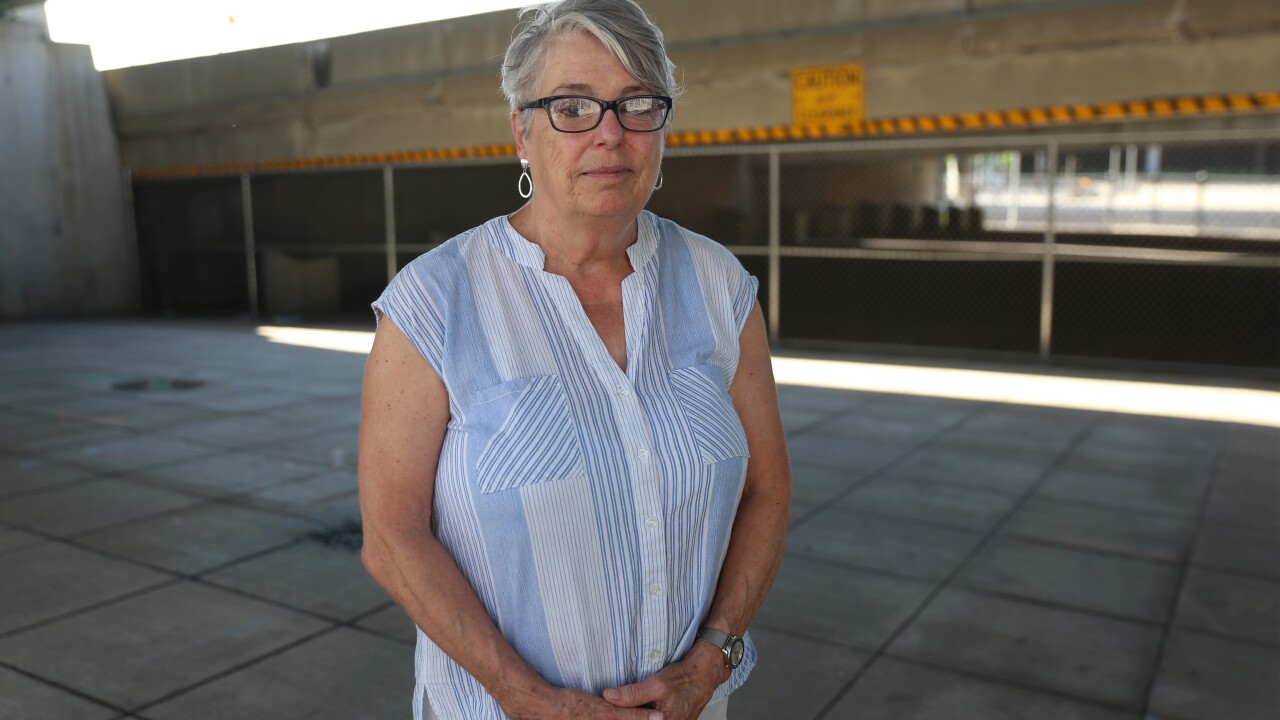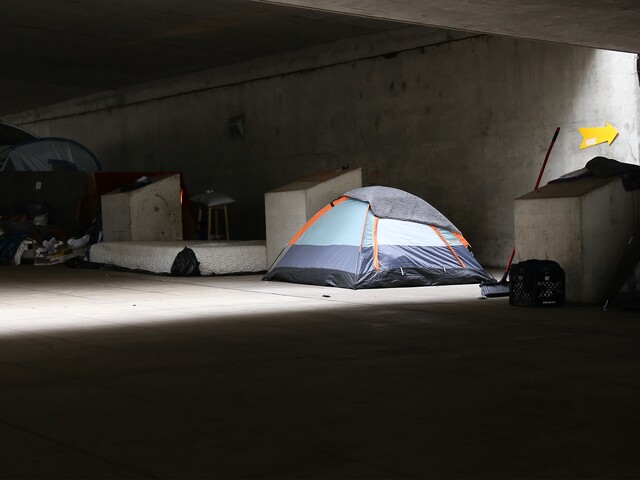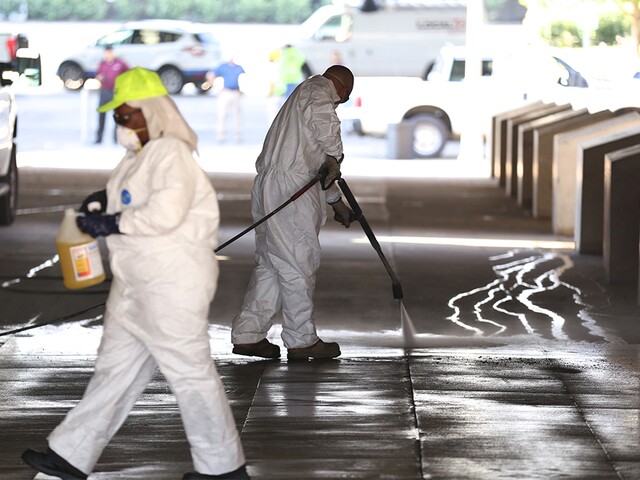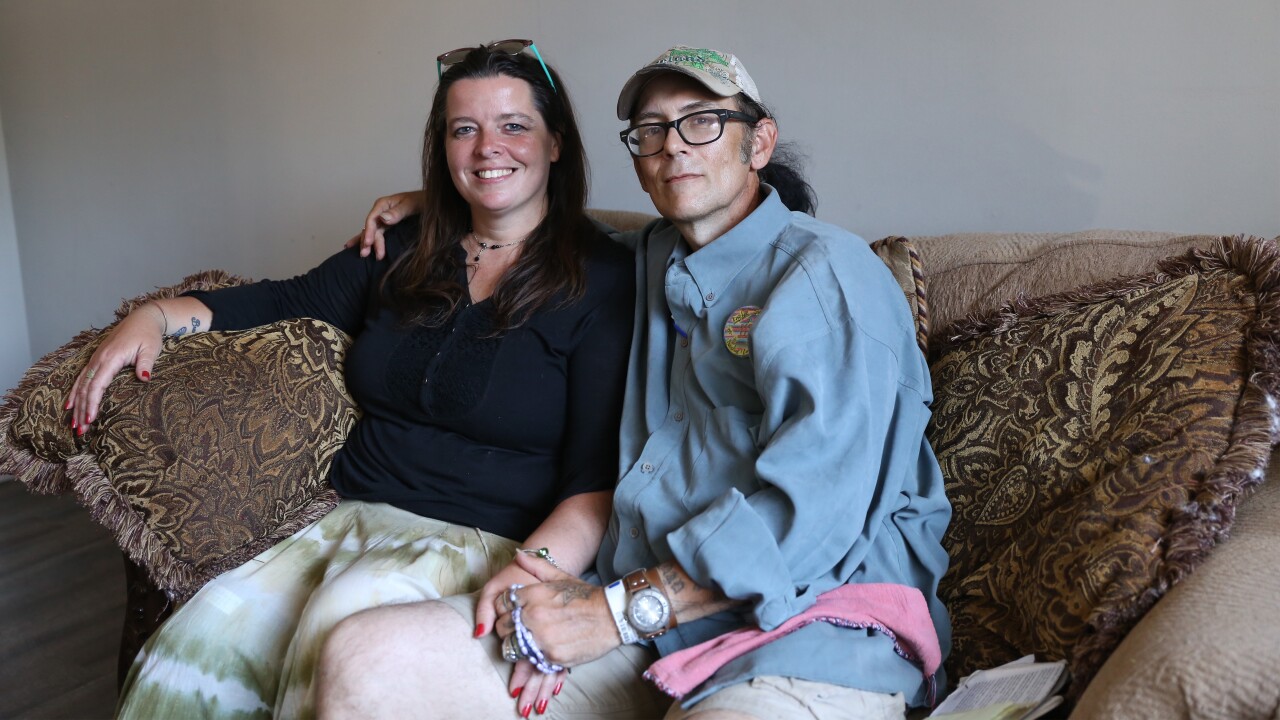CINCINNATI — April Collins sat atop a concrete bench on a recent Friday morning, sipping a beer and greeting passersby like the leader of a Third Street welcoming committee.
She used to spend her nights in a tent along the same street as part of a group of people experiencing homelessness known as The Colony.
It was one of the Downtown homeless camps that ignited controversy last summer.
A year ago this month, the city of Cincinnati began issuing a series of 72-hour notices requiring homeless people to move the tent cities they had established. The camps moved around town before dispersing completely after a Hamilton County judge’s countywide ban against homeless people sleeping outside.
RELATED: Cincinnati’s tent city: What have we learned?
Plenty of people like Collins still do, though. Now they are just out of sight of the Downtown businesses and residents that objected to their camps last summer.

“I’m living on the streets because it’s a choice, a choice I made,” said Collins, who is 38, and told WCPO she has been homeless for 17 years. “I’m not really ready to live somewhere permanently right at this moment. How do I explain that? I’ve had it taken from me twice. So I want to make sure I get all my ducks in a row. It’s just taking me time. Seventeen years is too long. But, hey, I don’t give up. I keep pushing forward.”
Advocates for the homeless have been pushing forward, too, with lawsuits challenging the Hamilton County ban pending in state and federal courts.
But while the legal questions remain unresolved, there has been change over the past year:
• Cincinnati City Council approved $350,000 to extend the amount of time that Shelterhouse can operate its low-barrier Winter Shelter to give people experiencing homelessness a place to sleep without a lot of other requirements.
• City council also approved $600,000 in initial funding for an Affordable Housing Trust Fund, with the total expected to grow over time.
• The city hired St. Vincent de Paul - Cincinnati to administer a new eviction prevention program in an effort to stop people from becoming homeless in the first place. The work began July 1, and the program has helped 21 households so far.
• Cincinnati Center City Development Corp., or 3CDC, will spend more than $300,000 this year on outreach workers for people experiencing homelessness and the operation of City Gospel Mission’s Jobs Van to provide day labor as an alternative to panhandling, among other initiatives.
• And a local firm hired to develop recommendations for how to help homeless people who can’t – or won’t – go to homeless shelters submitted its report in May.
“I think that the controversy over the summer and the lawsuit has had some effect,” said Josh Spring, executive director of the Greater Cincinnati Homeless Coalition. “Those conversations are not going far enough, but we are making progress.”
‘A total success’
The progress is clear as far as Downtown residents are concerned, said Sue Byrom, the president of the Downtown Residents Council who spoke out about her concerns last summer.
“It was getting really scary. A lot of residents were really concerned,” Byrom said of last summer’s camps. “It was horrible just looking at it, smelling it and understanding what they’re going through, or trying to understand what they’re going through.”
The difference in walking along Third Street this summer, she said, “is just night and day – thankfully.”

Hamilton County Prosecutor Joe Deters said he hears “thank you” a lot from Downtown residents and business owners.
Deters started the legal process last summer that resulted in the countywide ban against homeless people sleeping outside. The ban applies only if there is space available in homeless shelters, which advocates argue can be difficult to gauge.
“We really were careful to make sure that they had a place to go,” Deters said. “That it wasn’t just, ‘Get the hell out of Hamilton County.’ It was, look, there are places you can go that are healthy, and you’re going to dislodge.”
Deters filed a civil nuisance action against the city last August that included affidavits from Cincinnati Police Captain Michael Neville and interim Cincinnati Health Commissioner Marilyn Crumpton.
Neville’s affidavit said police had seen an increase in public drunkenness, felony drug abuse and public acts of defecation and urination and damage to public property, among other concerns.

Crumpton’s affidavit noted that the lack of sanitary conditions could lead to the spread of diseases at the camps and that life expectancy is decades shorter for people experiencing homelessness than for the general population.
The ban, Deters said, eliminated those problems the camps caused.
“It was a total success in terms of getting people from living on the streets into shelters where they had sanitary conditions and things like that,” he said. “It wasn’t to be mean to homeless people. It was to make sure that people weren’t getting sick.”
Advocates for the homeless and people who stayed at the camps don’t buy that, though, and both the state and federal lawsuits aim to overturn the countywide ban.
‘We know there will be a need’
Lawyers for the ACLU of Ohio are leading New Prospect Baptist Church’s challenge in state court, arguing the county’s lawsuit against the city didn’t involve the people most impacted by the action and that it was improper from the start.
RELATED: Six months later, did Cincinnati’s tent city have an impact?
Ohio’s First District Court of Appeals ruled in January that the legal challenge could proceed.
Residents of the encampments and the Greater Cincinnati Homeless Coalition filed their legal challenge in federal court. That lawsuit consists of several arguments. One is that that living outside is a constitutionally protected form of expression. Another is that Deters’ lawsuit against the city was “a sham legal process” because both sides wanted the same thing – to eliminate the camps.

Homeless camps were disbanded across Hamilton County following a growing encampment at Third and Plum streets in downtown Cincinnati last summer.
U.S. District Court Judge Timothy Black ruled in May that the plaintiffs in the federal case could add Cincinnati Mayor John Cranley as a defendant and proceed with many of their arguments.
“This, of course, is still an early stage of the lawsuit, but we believe that the feedback from Judge Black is thorough and is positive for our cause,” the homeless coalition’s Spring said. “He says that this case is important and by no means over, and so we are glad that he’s taking us seriously.”
The bigger picture, though, is that making it illegal to sleep in tents Downtown doesn’t address the larger problems, said a woman who calls herself Sunshine. She and her husband of 10 years, who calls himself Darkness, lived in a tent at The Colony last summer.
“I don’t think that just making it a rule that you’re not allowed to be homeless solves anything,” Sunshine said. “That is something that maybe we need to work on as a community.”
There is work happening.
The additional money to extend operations of Cincinnati’s Winter Shelter, in particular, should make a big difference for people experiencing homelessness, said Arlene Nolan, executive director of Shelterhouse.

Cincinnati City Council approved an additional $200,000 to help operate the shelter and $150,000 to add shower facilities, security cameras and make other improvements to the facility, Nolan said.
“Shelterhouse wanted to be part of the solution to what was going on last year,” she said. “We have 10,000 square feet of space that could be used for providing additional beds for people who want to get off the street or wherever they were sleeping and come in.”
Nolan said she needs to raise an extra $50,000 to $100,000 to make sure the shelter can operate as needed year-round, but she’s confident she can.
“We know there will be a need,” she said. “Honestly, before that ban went into effect, our occupancy levels were almost unheard of, it was so high.”
Those numbers convinced Nolan it didn’t make sense to let the Winter Shelter go unused for most of the year.
“People experience homelessness 24/7, 365 days a year. So all of us should be available whenever people reach out. And we have to be solutions-oriented,” she said. “We don’t think that the need is weather dependent anymore. I think it’s about people’s circumstances and what led them to be homeless.”
Official homeless count declining
A total of 7,036 people in Cincinnati and Hamilton County experienced homelessness in 2018, according to data collected by Strategies to End Homelessness, the nonprofit that oversees homeless services and distributes federal funding to service providers.
That’s a decrease of 2.2 percent since 2017 and a decrease of 3.7 percent since 2013, noted Kevin Finn, CEO of Strategies to End Homelessness.
The decrease in the number of people sleeping on the streets is even more dramatic, Finn said.
“All told now, over a six-year period, we have had a 40 percent decline in the number of people sleeping outside on the streets, not an increase,” he said. “I think a lot of things related to what happened last summer gave people the impression that there are more and more and more.”
Spring and Nolan argued it’s difficult to get a completely accurate count of people sleeping outside, in their cars or in vacant buildings. But Finn said Hamilton County’s outreach workers know where to look to find people.

The city of Cincinnati sent a cleaning crew to the area near Third and Plum streets where a group of homeless people were living. The group voluntarily left in the early hours of Wednesday, July 25, 2018 by 8 a.m. after the city implemented an eviction notice the week before.
Street outreach workers counted 1,692 people sleeping on the streets in Hamilton County in 2013, Finn said, and 965 people sleeping on the streets last year.
“What I would argue is that 2018 is the anomaly and every year leading up to 2018 was somewhat the same as what 2019 is like at this point,” he said.
Finn said the city inadvertently gave homeless people the impression they had permission to be Downtown after city workers cleaned an area near Third and Plum streets in April and then allowed people to move back after they were finished.
“The normal dynamic is when a homeless camp forms, the street outreach workers begin engaging with the people staying there to give them better options of places to go at the same time the police start applying some light pressure,” he said. “That combination of carrots and sticks keeps homeless camps relatively small and generally encourages people to make, hopefully, some sort of positive change in their situation.”
But last year’s cleaning amounted to eliminating the “stick,” Finn said, and the “carrots” alone weren’t enough.
The camps grew as word spread.
Street outreach workers collected the names of 38 people who were living at the Downtown camps last summer, Finn said.

Of those, six have moved into apartments, and four got matched with a housing program but never moved into a place.
One was back at a homeless shelter in June, and an outreach worker re-engaged another one in July.
The other 26 are missing from the system, which could mean that they moved out of town, found housing on their own or met some other fate, Finn said.
“There’s good and bad in that,” he said. “It’s bad to have so many people be an unknown. But generally speaking, the way people exit homelessness, even for positive reasons, is just all of a sudden they’re not in the system anymore.”
The true solution to the problem, Finn and Spring agreed, is to increase the amount of affordable housing in the region. Without a home that a family can truly afford, they said, homelessness is an ever-present threat.
Sunshine and Darkness are among the lucky ones.
‘It’s not a place to be’
They refused to go into shelter last summer because there was no place they could stay together. They had become homeless after Sunshine got injured. She lost her job as a paramedic and then they lost their home.
“We’ve stuck together through thick and thin,” Darkness said.
“We basically had each other, and we held tight on each other,” Sunshine added.
People at The Colony looked out for each other, too, she said. Sunshine and Darkness, who has worked as an EMT, stayed in a red tent so people could find them for medical help.
The Colony’s residents had systems for going to the bathroom, disposing of waste and washing their hands, Sunshine said. And Desmond Brown, the group’s leader, made sure everyone had jobs to do and kept the area along Third Street clean, she said.

“When we had our tents out there, they became signs,” Sunshine said. “That was our signs of sticking together and saying we’ve done everything we could to go get signed up for this and signed up for that and waiting for the programs and housing. We just didn’t have anywhere to go until then.”
Sunshine and Darkness moved their tent from spot to spot with The Colony until the camp had to disperse. They stayed with friends when they could after that but often slept in their car.
After about a year of homelessness, they got an apartment in April through Shelterhouse’s Rapid Rehousing program.
While they have many happy memories of their time with The Colony last year, both Sunshine and Darkness said it feels good to have a place of their own again.
“Stability comes to mind,” Darkness said. “A home, having a place to come back to every day.”
The first piece of furniture Sunshine bought was a dining room table because it represented family to her.
“We had so much and then we went to having almost nothing, but it was awesome,” Sunshine said. “We learned sticking together and we learned love and peace.”
They’re worried about people who are still out on the street, though, and want to find ways to help them, she said. They started a Facebook page about their experiences with The Colony in hopes that it will draw attention to the issue of homelessness.

“I see the other side now,” Sunshine said. “I want to help so much, and I think really the best way I’m able to help is by getting the word out.”
April Collins, meanwhile, continues to live on the streets. As she talked with a reporter, a GeneroCity 513 outreach worker gave her a bottle of water and a cigarette.
A Downtown Ambassador took a break from picking up litter to tell her how much he liked her haircut before giving her a cigarette, too.
“This is what it is down here. Everybody loves everybody,” she said with a broad smile. “They always come down here every day, seeing who they can find, seeing who needs help.”
Still, life on the street isn’t easy, Collins said. She feels like she has to hide now when she sleeps outside, she said, adding that she has friends who let her stay with them when she gets tired of being outside and being drunk.
“I’m not recommending it to nobody because it’s not a place to be,” she said. “You really can’t sleep at night. You’ve got to have some kind of weapon around you. It is what it is.”
Lucy May writes about the people, places and issues that define our region – to celebrate what makes the Tri-State great and shine a spotlight on issues we need to address. Poverty is an important focus for her and for WCPO. To reach Lucy, email lucy.may@wcpo.com. Follow her on Twitter @LucyMayCincy.











